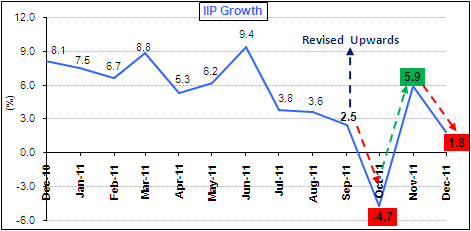After a sharp rise in the month of November 2011 (5.9%), the Index of Industrial Production (IIP) for the month of December 2011 dipped sharply to 1.8%. Meanwhile, the IIP for the month of September 2011 has been revised to 2.5% from 2.0% (provisional estimate) provided earlier.

(Source: CSO, PersonalFN Research)
The dunk in the IIP was led by the following:
- Manufacturing index, which constitutes about 76% of the industrial production, displayed a dismal growth of a meager 1.8% in the month of December 2011 (as against 6.2% in the previous month).
- Consumer goods too posted an uninspiring growth of 10.0% in the month of December 2011 as against 13.0% in the previous month.
- Capital goods were the worst of the lot as it posted a negative growth of -16.5% from -4.3% in the previous month.
Our View:
The IIP numbers clearly show a see-saw ride (as shown above in the graph). Since the past three to four months the IIP numbers have been quite volatile. The see-saw movement of the IIP is mainly due to the high base effect which is a statistical phenomenon. For instance the IIP number for the month of November 2010 stood at 6.4% and for December 2010 stood at 8.1%. This thus has an impact on the IIP numbers posted for the month of November 2011 and December 2011. Similarly, the same principal applies for the other constituents of the IIP number like the manufacturing index, consumer goods index and the capital goods index. However, now that the interest rates are about to peak out and soon we may see rate cuts by the RBI, the easing interest rates is likely to be a boost to the manufacturing sector which in turn will boost production. Also, with the easy money policy being deployed in the developed nations, the Emerging nations like India are likely to receive inflows due to the robust growth potential offered by them.
What should equity investors do?
The Indian equity markets are resilient in nature and have potential for a robust future growth. Investors in equity should adopt calm and compose approach and stay invested from a long term point of view.
However, as fears of downbeat economic data being disseminated from the Euro zone still remains, staggering your investments would be an appropriate approach. We recommend that you invest in diversified equity funds as this will help reduce risk. However one should stay away from U.S. or Euro oriented offshore funds in such a scenario, and instead look at investing in domestic value style equity funds. Ideally you should opt for the SIP (Systematic Investment Plan) mode of investing as this will help you to manage the volatility of the equity markets well (through rupee-cost averaging) and also provide your investments with the power of compounding .
Remember, while investing select only those equity funds which follow strong investment processes and systems, and invest with a long-term horizon of at least 5 years.
What should debt investors do?
Well, we think that the current situation is attractive to take exposure to debt mutual fund instruments as interest rates are likely to consolidate at these higher levels before they start going down.
You can now gradually take exposure to pure income and short-term Government securities funds. Since longer tenor papers will become attractive, longer duration funds (preferably through dynamic bond / flexi-debt funds) can be also considered, if one has a longer investment horizon (of say 2 to 3 years). However, one may witness some volatility in the near term as there is always an interest rate risk associated with the longer maturity instruments.
With liquidity in the system being tight, yield on the short term instruments is expected to remain high thus making short-term papers attractive. Hence investors with a short-term time horizon (of less than 3 months) would be better-off investing in liquid funds for the next 1 month or liquid plus funds for next 3 to 6 months horizon. However, investors with a medium term investment horizon (of over 6 months), may allocate their investments to floating rate funds. Short term income funds should be held strictly with a 1 year time horizon.
Fixed Maturity Plans (FMPs) of 2 months to 1 year will yield appealing returns and can also be considered as an option to bank FDs only if you are willing to hold it till maturity, but you may not have a very attractive post tax benefit, as indexation benefit will not be available on FMPs maturing within 2 months. You can consider investing your money in Fixed Deposits (FDs) as well; at present 1 year FDs are offering interest in the range of 7.25% - 9.40% p.a.
Add Comments
| Comments |
email@gmail.com
Aug 27, 2014
I have recently started a website, the information you provide on this site has helped me greatly. Thanks for all of your time & work. |
email@gmail.com
Dec 17, 2014
Thanks a lot for the post.Really thank you! Will read on... |
email@gmail.com
Feb 05, 2015
npkQ37 My brother recommended I may like this blog. He used to be totally right. This post truly made my day. You can not consider simply how a lot time I had spent for this info! Thank you! |
dlawrence@lippingroup.com
Feb 25, 2012
Interesting acrltie. Were did you got all the information from . very cool website. I liked the acrlties and particularly some of the comments posted. Additional A rise in A lot more. |
randumbidiocy@gmail.com
Feb 25, 2012
Terrific post however , I was wanting to know if you could write a litte more on this topic? I'd be very grateful if you could elaborate a little bit further. Thank you! |
1